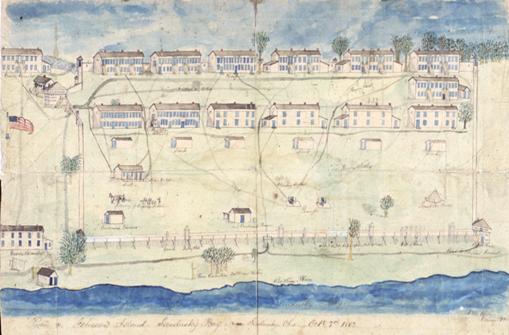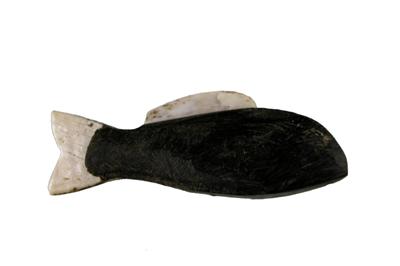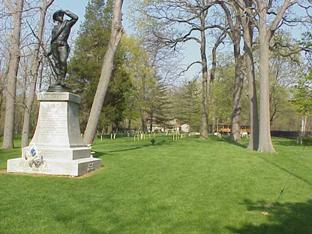|
Threat to Site |
| Why the prison is
at risk, and what can be done about it |
| |
|
Camp History |
| History of the
Johnson's Island Prisoner of War Depot |
| |
|
|
|
|
Camp History
Johnson's Island Prisoner
of War Depot
From April of 1862 until
September of 1865, over 10,000 Confederates passed through
Johnsonís Island Civil War Military Prison leaving behind an
extensive historical and archaeological record. Many of
these officers recorded in journals or diaries the day to
day happenings, emotions, and conditions they were enduring.
They also spent many hours writing letters, collecting
autographs from prisoners, and sketching maps. These
documents give vast insight into what prison life was like,
as well as the personal conflicts and hardships encountered
among families and friends during the Civil War.
 The 16.5 acre Johnsonís
Island Prison Compound contained 13 Blocks (12 as prisoner
housing units and one as a hospital), latrines, sutlerís
stand, 3 wells, pest house, 2 large mess halls (added in
August, 1864) and more. The Blocks were two stories high and
approximately 130 by 24 feet. There were more than 40
buildings outside the stockade (barns, stables, a lime kiln,
forts, barracks for officers, a powder magazine, etc.) used
by the 128th Ohio Volunteer Infantry to guard the prison.
The two major fortifications (Forts Johnson and Hill)
protecting Johnson's Island were constructed over the
1864/65 winter, and were operational by March of 1865. The 16.5 acre Johnsonís
Island Prison Compound contained 13 Blocks (12 as prisoner
housing units and one as a hospital), latrines, sutlerís
stand, 3 wells, pest house, 2 large mess halls (added in
August, 1864) and more. The Blocks were two stories high and
approximately 130 by 24 feet. There were more than 40
buildings outside the stockade (barns, stables, a lime kiln,
forts, barracks for officers, a powder magazine, etc.) used
by the 128th Ohio Volunteer Infantry to guard the prison.
The two major fortifications (Forts Johnson and Hill)
protecting Johnson's Island were constructed over the
1864/65 winter, and were operational by March of 1865.
The Hoffman Battalion
with other companies that formed the 128th Ohio Volunteer
Infantry became the official guards of the prison under the
charge of William S. Pierson, former mayor of Sandusky.
Because of his cruelty to prisoners and his inability to
handle problems and keep the prison in good order, he was
replaced. On January 18, 1864 Brigadier General Harry D.
Terry replaced Pierson. A few months later, on May 9, 1864,
Colonel Charles W. Hill took command at Johnson's Island,
remaining as such until the end of the war.
 As prisoners of war, they
daily faced how to cope with their situation, whether to
resist, to survive, or to assimilate by taking the Oath of
Allegiance. Their choices resulted in a variety of
activities taking place. Those contemplating escape spent
time preparing...whether disguising as a guard, walking
across the frozen lake into Canada, or tunneling from a
latrine... any idea took great planning and time to
orchestrate. Some prisoners used their talents and limited
resources to pass the time by carving rings, broaches, and
other jewelry out of hard rubber, bone, and shell. Reading,
especially newspapers was important to keep informed of the
latest victories and defeats of the War, government actions,
and news of exchanges. As prisoners of war, they
daily faced how to cope with their situation, whether to
resist, to survive, or to assimilate by taking the Oath of
Allegiance. Their choices resulted in a variety of
activities taking place. Those contemplating escape spent
time preparing...whether disguising as a guard, walking
across the frozen lake into Canada, or tunneling from a
latrine... any idea took great planning and time to
orchestrate. Some prisoners used their talents and limited
resources to pass the time by carving rings, broaches, and
other jewelry out of hard rubber, bone, and shell. Reading,
especially newspapers was important to keep informed of the
latest victories and defeats of the War, government actions,
and news of exchanges.
Prisoners could receive
packages and mail. The mail was inspected and the parcels
were searched and often damaged or depleted before the
prisoner received them. Consequently prisoners often relied
on the sutler store to buy sewing supplies, ink, stationery,
clothes, food, combs, toothbrushes, etc. These items could
be purchased until late in the war when food, along with
other items, were no longer permitted to be sold by the
sutler.
 The prisoners on
Johnsonís Island, along with most of the soldiers that
fought in the Civil War endured harsh winters, food and fuel
shortages, disease, along with the mental anguish of
uncertainty about their families and their own futures.
Current research suggests that close to 300 prisoners died
on Johnsonís Island during the war. The prisoners on
Johnsonís Island, along with most of the soldiers that
fought in the Civil War endured harsh winters, food and fuel
shortages, disease, along with the mental anguish of
uncertainty about their families and their own futures.
Current research suggests that close to 300 prisoners died
on Johnsonís Island during the war.
After the Civil War, most
of the buildings on Johnsonís Island were auctioned off. The
land was used for farming, and quarrying started in the late
1800ís. The resort business began around then also, but
eventually failed. Residential building began in the 1950ís
allowing private residents to enjoy waterfront properties.
In 1990, Johnsonís Island was designated as a National
Historic Landmark recognizing its significance in the Civil
War as one of the premier Union prisons. The Confederate
Cemetery, located on Johnsonís Island is currently the only
publicly available part of the prison. A portion of the
prison compound and all of Fort Johnson have been set aside
for long term preservation by the current landowner. |